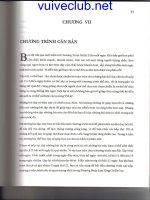Tài liệu The Chemical Cosmos ppt
Bạn đang xem bản rút gọn của tài liệu. Xem và tải ngay bản đầy đủ của tài liệu tại đây (2.81 MB, 246 trang )
For further volumes:
/> Astronomers’ Universe
wwwwwwwww
Steve Miller
The Chemical Cosmos
A Guided Tour
Steve Miller
Department of Science and Technology Studies
University College London
Gower Street, WC1E 6BT London, UK
ISBN 978-1-4419-8443-2 e-ISBN 978-1-4419-8444-9
DOI 10.1007/978-1-4419-8444-9
Springer New York Dordrecht Heidelberg London
Library of Congress Control Number: 2011937447
© Springer Science+Business Media, LLC 2012
All rights reserved. This work may not be translated or copied in whole or in part without
the written permission of the publisher (Springer Science+Business Media, LLC, 233
Spring Street, New York, NY 10013, USA), except for brief excerpts in connection with
reviews or scholarly analysis. Use in connection with any form of information storage
and retrieval, electronic adaptation, computer software, or by similar or dissimilar
methodology now known or hereafter developed is forbidden.
The use in this publication of trade names, trademarks, service marks, and similar terms,
even if they are not identified as such, is not to be taken as an expression of opinion as to
whether or not they are subject to proprietary rights.
Printed on acid-free paper
Springer is part of Springer Science+Business Media (www.springer.com)
For Vanessa
wwwwwwwww
vii
Acknowledgements
This book was largely written whilst I was on sabbatical leave
from University College London (UCL) in 2009 at the Institute for
Astronomy (IfA) in Hilo, Hawaii. So I would like to thank my Dean
at UCL, Professor Richard Catlow, and Professor Alan Tokunaga,
Director of the NASA Infrared Telescope Facility and my host at
the IfA. Professor Bob Joseph, also of the IfA, introduced me to
Hawaii and infrared astronomical observing, and shared much of
his great enthusiasm for both with me. Over my 25 years at UCL,
it has been an enormous pleasure to work with some great friends
and colleagues in both the Department of Physics and Astronomy
and the Department of Science and Technology Studies, and their
support and encouragement in my various enterprises is much
appreciated. Professor David Williams (UCL), Dr Tom Stallard
(University of Leicester) and Dr Declan Fahy (American Univer-
sity, Washington) all read various versions of the book, and their
insightful and helpful comments have improved it enormously.
(The faults remain mine, however.) I would like to thank the edi-
torial team at Springer – Jessica Fricchione and Harry Blom – for
their advice and patience. Above all, this book has been inspired
by the work of Professor Jonathan Tennyson (UCL) and Professor
Takeshi Oka (University of Chicago). Long may it continue.
wwwwwwwww
ix
Contents
Acknowledgements vii
1. Purple Haze: Introducing Our Guide 1
2. The Early Universe: The Source of Chemistry –
and of Our Guide 9
3. Shooting the Rapids: The Life and Death
of the Earliest Stars 25
4. Heading Downstream and Cooking by Starlight 63
5. Fishing for Molecules 91
6. Branching Out: In the Land of the Giants
and Dwarves 115
7. In the Delta: Exoplanets – Worlds, but Not
as We Know Them 153
8. Towards the Sea of Life 171
Epilogue 191
Annotated References and Further Reading to Chapters 195
Some Useful Numbers 221
Pictures and Figures 223
Index 227
wwwwwwwww
xi
Prologue
In the beginning, there was Hydrogen. And not a lot else. Okay,
there was some Helium, Lithium and a heavy form of Hydrogen
called Deuterium. But there was none of the Carbon, Oxygen,
Nitrogen, Sulfur, Phosphorus, Calcium, Sodium, etc. that are vital
to our very existence. But here we are, and today we know of 110
chemical elements forming literally billions of chemical com-
pounds. Some of these compounds are sufficiently ingenious that
they can replicate by themselves; some of them are sufficiently
sociable that they team up to form living creatures – algae, bacte-
ria and – eventually – life-forms such as ourselves. So how do we
get from Hydrogen (plus a few friends) to where we are now? The
answer is provided by astronomy, the study of the heavens bright
and dark.
Astronomy is a journey: it is a journey over enormous dis-
tances to other worlds, other stars and other galaxies. It is also a
journey back in time. Light takes time to cross the vast distances
of empty space. So astronomers are always looking at other worlds,
stars or galaxies as they were when the light by which we see them
first left home to reach us. In this book, we shall take a chemical
journey, following the flow of the Chemical Cosmos from its
source in the early universe all the way down to the sea of life. So
vast is the journey that we will need a guide, one with an adven-
turous spirit, one prepared to endure many hardships, and one that
will pop up when we most need it, but least expect it. Our guide
will be of simple but ubiquitous parentage. It will be both stable
and energetic; it will have been there since the beginning of the
Chemical Cosmos, and it will be there at its end.
Some time before the end of the decade, or thereabouts, if
enough money can be found, a huge space telescope will blast
off from a launch site in French Guyana. The James Webb Space
Telescope will be ten times as powerful as the current Hubble
Space Telescope. It will examine the sky in the infrared part of the
xii Prologue
spectrum – wavelengths longer than visible red light, responsible
both for heating and for cooling the universe. What it will probe
is the Chemical Cosmos, the river of astronomical chemistry that
has its source in the early universe and takes us all the way to the
sea of life. Much of what the James Webb Space Telescope finds
will be due, directly or indirectly, to our guide along this river
journey. Our guide needs an introduction.
S. Miller, The Chemical Cosmos: A Guided Tour,
Astronomers’ Universe, DOI 10.1007/978-1-4419-8444-9_1,
© Springer Science+Business Media, LLC 2012
1. Purple Haze: Introducing
Our Guide
Outside of Chicago’s City Hall is a giant Picasso sculpture of a
weeping woman. For the more artistically challenged, it takes
quite a while before you can “see” it, before you can really make
out what Picasso was getting at and how he got there. Five miles
to the south of City Hall, in the basement of the University of Chi-
cago’s Chemistry Department, lies a piece of glassware of which
the great artist would have been proud.
Again to the uninitiated, it takes quite a while to “see” it. It
looks like a deranged spider; indeed, those who work with it call
it the Tarantula. When it is working in the darkened laboratory
in which it sits, it is suffused by a purple haze and resonates to
an electric hum. The Tarantula is not a work of art in the con-
ventional sense, although it is certainly a tribute to the art of the
glassblower who made it. This artistic glassware is a discharge
tube, a device for making electrically charged chemicals that are
normally only found high up in the atmosphere or in the depths
of outer space.
We will be returning to the Tarantula shortly.
The Tarantula’s owner is Takeshi (just call me) Oka, (now
Emeritus) Professor of Chemistry and Astronomy, graduate of the
University of Tokyo, distinguished member of the British and the
Canadian Royal Societies, holder of many other distinctions from a
scientific career that now spans six decades (Figure 1.1 ). In Chicago,
Oka runs the “Oka Ion Factory” , a laboratory that has paved the
way in the study of chemicals that are called “molecular ions”.
Ions derive their name from the Greek ion , meaning “moving
thing,” and they were given this name by Michael Faraday, Pro-
fessor of Chemistry at the Royal Institution in London between
the years of 1833 and his death in 1867. Ions, explained Faraday,
are what move in a chemical solution, or – in a more modern
1
The Chemical Cosmos
application – a fluorescent light tube, when you run an electric
current through it. Opposites attract – cations are positively
charged, and travel towards the negatively charged cathode.
Conversely anions are negatively charged and head for the – you
guessed it – positively charged anode.
The smallest element of negative charge is called the elec-
tron, the first sub-atomic particle ever discovered in 1897 by the
British physicist Joseph John (J.J.) Thomson (Figure 1.2 ). Atoms are
made up of electrons surrounding a nucleus, positively charged
protons and electrically neutral neutrons. Atoms may become
positively charged by dumping a negatively charged electron; and
they then become cations like the Sodium atom in common table
salt. Or atoms may become negatively charged by picking up an
electron and then become anions like the Chlorine atom in the
same salt crystal.
Molecules are groups of atoms more or less tightly held
together, like Water. In Water, two Hydrogen atoms combine with
one Oxygen atom to form the Water molecule. Molecular ions are
electrically charged molecules that have either been careless with
their electrons – molecular cations – or greedy for them – molecular
Figure 1.1 Takeshi Oka at work in his laboratory at the University of
Chicago: credit – Oka Ion Factory, University of Chicago.
2
Purple Haze: Introducing Our Guide
anions. Molecular ions are literally everywhere, and even in Water,
that benign prerequisite of life as we know it, one molecule in ten
million has had enough of neutrality and become a cation. And,
to maintain electrical balance, one has become an anion; therefore
scientists find molecular ions fascinating.
Oka with his Ion Factory is to molecular ions what Henry
Ford was to automobiles. (The Ion Factory could also have been
called the Professor Factory; there is many a university around
the world who owes at least one of its Chemistry professors to the
training they received at the hands of Oka, and fellowship his lab
generated.) But this is not the story of the Oka Ion Factory itself,
although we shall return to it again in our story. Our adventure
goes way beyond the confines of the University of Chicago, far
out into space beyond our galaxy, the Milky Way, and far back in
time to an era in which very few of the chemicals that make up
our world had been formed. On our adventure, we shall follow the
fortunes of a tiny triangular adventurer, so small that ten billion
of them standing in line stretch for little more than a meter.
Figure 1.2 J.J. Thomson giving a lecture demonstration in the Caven-
dish Laboratory at the University of Cambridge: credit – The Cavendish
Laboratory, University of Cambridge.
3
The Chemical Cosmos
Our guide is a molecular ion that goes by the name of H
3
+
(read H-three-plus, if you want to). So what, exactly, is H
3
+
you
may ask?
For starters there is a big clue or two in the name. All ele-
ments have a chemical sign to indicate their atoms – H for Hydro-
gen, He for Helium, C for Carbon, N for Nitrogen, O for Oxygen,
Cl for Chlorine, etc. So you can see that the chemical signs are
either one or two letters long. When atoms combine to form a
molecule, the molecule gets its own chemical symbol, known as
a formula, derived from the atoms that make it up. The formula
for common salt is NaCl, which shows that it is made up of equal
numbers of Sodium (Na for the Latin word, Natrium) and Chlorine
(Cl) atoms. The formula of Water, H
2
O, indicates Hydrogen atoms
combining with Oxygen in the ratio of two-to-one.
But H
3
+
only has ‘H’ in it; there are no other atoms in it. In an
exclusive fashion, in H
3
+
, Hydrogen has decided simply to combine
with itself, and it turns out that this is not so unusual. Oxygen
atoms like to hang around in pairs, if there is no better offer at hand,
to form O
2
molecules, the stuff of air that we take in through the
walls of our lungs to keep us alive. Nitrogen and Chlorine atoms
will also happily keep each other company, as N
2
and Cl
2
. And
Hydrogen is most often found doubled up as the molecule H
2
.
Nor is three necessarily a crowd. Oxygen atoms will hold
hands with two others to form Ozone, O
3
, a pollutant at street
level but a life saver high in the Earth’s atmosphere where it blocks
out harmful ultraviolet radiation. Indeed, if it were not for Oxygen
“tripling up” in the form of Ozone, life on Earth would be impos-
sible today. And there are many atoms that will form huge con-
glomerates. Pure Carbon is the most prolific of them all; it forms
endless chains in graphite, extensive crystals in diamond and ball-
shaped clusters of C
60
– 60 atoms of Carbon joined together in the
form of a miniature soccer ball – and even bigger.
So we should not be surprised at three Hydrogens hanging out
together, although – as we will see later – it actually was a surprise
when it was first discovered.
The second clue from the name is the plus sign – H
3
+
. This
means that we are being introduced to a cation, positively charged.
In former and more formal times, when someone was intro-
duced, it was customary to enquire after the family to which the
4
Purple Haze: Introducing Our Guide
newcomer belonged. After all, one did not want to be consorting
with any old riff-raff, one wanted to be sure that one was talking
to the right Kennedys or the right Windsors.
Chemists tend to think of ions as being the offspring of parent
atoms or molecules. In common salt, Sodium exists as a positive
cation – Na
+
- and Chlorine as a negative anion – Cl
−
. These ions
are the children of their neutral parents, Na and Cl respectively.
Protocol has been observed; we are talking to the right Sodium
cation and the right Chlorine anion. Sodium is a great guy, stable
and well respected, part of the Alkali Metal clan whose ancestors
go all the way back to the Big Bang. And you could not wish for a
nicer girl than Chlorine, a member of the bustling Halogen family.
No wonder they have such great ions as offspring and that those
offspring go so well together.
Any logically thinking person by now would have worked
out that the parent of H
3
+
is good old H
3
. But H
3
is the parent you
do not really want to talk about: H
3
is unstable and as elusive as
an “ex” behind with the alimony, bringing us back to the Taran-
tula in the Oka Ion Factory, glowing purple as the electricity flows
through it.
Hydrogen is the simplest of all atoms made up of a nucleus
that is a single, positively charged proton. All atoms have protons,
but Hydrogen has only one. The proton is over 1,800 times more
massive that the electron, and the positive charge of the proton
is balanced by the negative charge of just one electron – together
they make up the Hydrogen atom. This means that the Hydrogen
ion, H
+
, and the proton are one and the same.
Oka’s Tarantula can be filled with pure Hydrogen gas, the
paired up H
2
form. As the electricity flows through the gas, some
of it is ionized – broken up into loose electrons and positively
charged Hydrogen ions, swimming in a sea of ordinary Hydrogen
gas. Although the gas is at low pressures, Hydrogen molecules and
Hydrogen ions bang into each other millions of times every second,
sometimes sticking together. The net result of all this excitement
is that a neutral Hydrogen molecule, H
2
, picks up a Hydrogen ion,
H
+
, to form our adventurer H
3
+
.
This process turns out to be one of the most fundamental of all
chemical reactions in the universe. We encounter it not just in the
basement of the University of Chicago’s Chemistry Department,
5
The Chemical Cosmos
but in the atmospheres of the giant planets like Jupiter and Saturn.
We also encounter it in other planets that exist beyond our Solar
System, in the top layers of stars that are among the earliest ever
born, and in the vast gas clouds that fill up not just the Milky Way,
but galaxies as far as we can see. It is a process that is nearly as old
as the universe itself, much older than the formation of Water or
common salt.
So now when H
3
+
introduces itself, it can keep quiet about
its wayward parent H
3
. Instead, it can boast of the proud union
between the stable and respected H
2
, a molecule with quite liter-
ally ‘universal’ appeal, and the most fundamental of all nuclear
particles, the proton H
+
. Indeed, our chemical guide can say, “I’m
Protonated Hydrogen.”
Hydrogen is the most abundant chemical in the universe; nine
out of ten atoms are Hydrogen. Helium makes up almost all of the
rest, and the Carbon, Oxygen, Nitrogen, and all the other atoms
that are so important for the framework of our Earth and ourselves
add up to only one thousandth of the atoms in the universe. So any
molecule that can boast a parentage of pure Hydrogen is part of a
very prolific tribe.
It turns out that, unlike the wayward parent H
3
, the offspring
H
3
+
is a stable chemical and its parts are strongly bound together. It
can boldly go into some of the most challenging of environments,
but because it is an ion – a positively charged cation – it is very
reactive. So it makes things happen everywhere it goes. Child of
the most abundant species in the universe, reactive in a way that
none of its relatives can match – that is why the adventures of H
3
+
are the most energetic and far-reaching we can wish for.
Our adventure with H
3
+
will take us to the giant planets Jupi-
ter, Saturn and Uranus. It will take us out of our Solar System
and into the planetary systems that have been discovered around
nearby stars, stars that are to be found within a few to a few tens of
light years from the Sun, but which are probably typical of billions
of billions of stars within our own galaxy, the Milky Way, and gal-
axies that lie beyond it. Voyaging with our little chemical guide,
we shall traverse giant clouds of gas and dust that lie between the
stars all the way to the center of the Milky Way, where a giant black
hole consumes all who venture too closely. On the way we will
visit some of the oldest stars in the galaxy and will even journey
6
Purple Haze: Introducing Our Guide
to our neighbor galaxy, the Large Magellanic Cloud, to see what
H
3
+
can tell us about the death of a star many times larger than our
own “little” Sun. And it may be that our adventurer played a part
in ensuring that the Solar System evolved in such a way that life
on Earth could evolve.
Our guide also takes us into a world little appreciated here on
Earth, although ubiquitous in space – the world of plasmas. The
Greek philosopher Aristotle had four elements – Earth, Water, Air,
and Fire. Today, we consider everyday matter to exist in the states
of solid, liquid and gas, which could be thought of as correspond-
ing to Aristotle’s Earth, Water and Air. Plasma is the fourth state
of matter, not fire; plasma consists of electrically charged gases of
very low density. The Solar System is filled with plasma: the solar
wind, a stream of electrically charged particles that pour out con-
tinuously from our Sun causing beautiful aurorae and destructive
electrical storms, is plasma. Plasma is the home of H
3
+
, and it is in
this environment that our guide first lights the chemical fires that
lead all the way to the building block of life itself.
First, though, we will journey back in time some 13½ billion
years to start of our universe, the source of our river of cosmic
chemistry. Way to go for such a simple little molecule!
7
wwwwwwwww
S. Miller, The Chemical Cosmos: A Guided Tour,
Astronomers’ Universe, DOI 10.1007/978-1-4419-8444-9_2,
© Springer Science+Business Media, LLC 2012
2. The Early Universe:
The Source of Chemistry –
and of Our Guide
On March 30, 2010, an experiment called the Large Hadron
Collider (LHC) succeeded in crashing together two beams of pro-
tons at the colossal energy of 7 million million electron volts. (An
electron volt is the energy given to one electron passing through
an electric field of 1 V.) This was energy 3½ times greater than any-
thing achieved before, and made up for a nervous 18 months while
scientists waited to see if the billions spent on the LHC were jus-
tified. This enormous particle collider is housed in a vast tunnel
spanning the border between France and Switzerland at the Euro-
pean Nuclear Research Centre (CERN) near Geneva. Operating
100 m underground, the LHC is the latest in a long line of experi-
ments designed to investigate the world at a sub-atomic level and
is now the most powerful tool at the disposal of scientists who
work in the area of particle physics. With it, particle physicists are
attempting to recreate the conditions of the very early universe.
Immediately after its birth – at least, if the current theories are
to be believed – the universe was a very energetic place. Protons and
electrons ran around freely, along with neutrons – neutral particles
with a mass very similar to the proton – while a zoo of other more
exotic fundamental particles rushed to and fro like traders in a bear
market. In addition to the particles of matter, there were also the par-
ticles of light known as photons, particles that have no mass of their
own, and because the negatively charged electrons and positively
charged protons interact strongly with light, photons were “trapped”
in with the ordinary matter in a hot, vigorous soup.
This brief sketch – and it is just that – derives from the best
theory that we currently have to explain the universe that we live in.
Because it starts with an “explosion” of truly cosmic proportions,
9
The Chemical Cosmos
it was nicknamed the “Big Bang” by people who did not believe
in it, and who began to ridicule it. The Big Bang Universe is not
just a whim, though, because it is strongly supported by scientific
evidence – the expansion of the universe measured by galaxies and
clusters of galaxies racing away from one another, the discovery of
the afterglow of the initial explosion, and, crucially for our story,
the chemical composition of the universe. Indeed, the Big Bang was
initially proposed to explain the whole of cosmic chemistry.
The biologist J.B.S. Haldane was once asked if he could
deduce anything about God from his study of the natural world.
So the story goes, Haldane replied that if He did exist, the Creator
had “an inordinate fondness for beetles” – they are everywhere,
in species too numerous to name. Astronomers who were asked
the same question might answer to the effect that God had “an
inordinate fondness for Hydrogen”. Hydrogen is the lightest and
simplest of all atoms, comprised of just one positively charged
proton orbited by one negatively charged electron. It, too, is every-
where; some nine out of ten of all atoms are Hydrogen atoms, and
it makes up nearly three fourth of the mass of ordinary matter in
the universe.
Although Hydrogen is the lightest and the most abundant of
all elements, it is not alone in the universe, which is fortunate for
Carbon-based life forms such as ourselves. It is joined by a 100+
series of heavier elements, the next heaviest and most abundant
element being Helium, Element 2, which makes up 24% by mass
of the ordinary matter of the universe. Carbon, Element 6 and 12
times as heavy as Hydrogen, makes up just half a percent of the
ordinary matter mass; Oxygen, Element 8 and 16 times heavier
than Hydrogen, makes up just 1%. In between them, Element 7,
Nitrogen, contributes just a tenth of a percent to the mass of ordi-
nary matter. As the element number and the mass increases, so
the proportion found in the universe decreases, at least until the
very heavy elements are reached.
In the immediate aftermath of World War II, with the images
of the atomic explosions of Hiroshima and Nagasaki still fresh,
George Gamow of George Washington University pointed out that
one could explain the fact that there were fewer heavy chemical
elements than light ones if the early universe were in a highly
unequilibrium state – far out of energetic balance with itself – and
10
The Early Universe: The Source of Chemistry
was expanding and cooling rapidly following an initial explosive
event. Since the nucleus of heavy elements would take longer to
build out of the fundamental protons and neutrons that made it
up, heavy elements would be rare if the time available to make
them were short. And time was short for the expanding universe,
product of the Big Bang explosion, was both rapidly cooling and
getting less dense. So the chances of sufficient protons and neu-
trons coming together with enough energy to produce heavier and
heavier elements got slimmer and slimmer as time went on. This
was why, Gamow argued, the abundance of heavy elements would
fall off dramatically as the element became heavier – which was
exactly what astronomers observed as well.
Gamow was right but the trouble was he was too right. Cal-
culations on the Big Bang universe showed that the temperature
and density of the early universe fell so rapidly that all that could
be formed were the nuclei of Elements 1 through 3 – Hydrogen,
Helium and Lithium – and Deuterium, a heavy form of Hydro-
gen that we will come across later. That made the early universe
chemically simple, with just three chemical elements, but left
unanswered how heavier elements, such as Carbon, Nitrogen and
Oxygen and the other 100-plus elements, were formed. To answer
that question, a subtle blend of astro-physics and astro-chemistry
is required.
The early universe is clearly a product of what happens in the
physical Big Bang and its immediate aftermath. It did not really
start to be a chemical universe, though, until at least a hundred
thousand years after the initial cosmic explosion, and probably
more like 300,000 to 400,000 years. By that time, the temperature
of the universe had fallen to a “mere” 4,000 degrees cooling to
3,000 degrees above absolute zero, still hot enough to melt almost
anything except diamond (not that diamonds existed at this time,
since there was no Carbon to form them) but cool compared with
earlier times. (From now on, we will use the symbol K to denote
“degrees above absolute zero”. K stands for kelvin, and absolute
zero is -273.15 degrees Centigrade. Note that a kelvin is the same
temperature interval as a degree Centigrade. So temperatures
expressed in kelvin, K, will always be 273.15 greater than tem-
peratures expressed in degrees Centigrade.) Once the temperature
got below about 3,000K, about 300,000 years after the Big Bang,
11
The Chemical Cosmos
positively charged protons – the nucleus of a Hydrogen atom – could
(re-)combine with negatively charged electrons to form neutral
Hydrogen atoms for the first time; electrons had teamed up with
Lithium and Helium nuclei to form neutral atoms a “bit” earlier.
Meanwhile, photons, the particles of light that had been trapped in
the proton/electron soup of the very early universe, could escape
and wander free. Matter and radiation were now no longer tightly
coupled and could act independently of one another.
This period, extending from around 100,000 to 400,000 years
after the Big Bang, is called the “Recombination Era,” and more
than 13 billion years later, we can still measure the light that
first escaped at the time of the Recombination Era. Over time,
and as the universe has expanded, the temperature of this all-
pervasive background radiation has cooled from some 3,000K to
just 2.73K and its wavelength has lengthened from (infra-)red to
microwave, but it is there wherever we look out into space. This
Cosmic Microwave Background Radiation, as it is known, was
discovered in 1964 by American radio astronomers Arno Penzias
and Robert Wilson, and for most astronomers that pretty much
ended the argument about whether the universe started with a
Big Bang or whether it had existed in a steady state from time
immemorial.
So the Cosmic Microwave Background Radiation is the
oldest radiation in the universe, and it carries in it the imprint of
what the cosmos looked like and how it was structured in those
early days. As well as allowing us to understand the universe at
early times, however, it also acts as a veil; although we can derive
theories about what went on before, and even try to simulate what
happened in enormous particle accelerators such as the LHC, we
cannot actually see further back in time than the time at which
recombination happened, the time at which atoms started to form.
The first few hundred thousand years of the universe are veiled off
from direct observation, no matter how powerful our telescopes or
how sensitive our instruments.
The Recombination Era produced the first electrically neutral
atoms in the universe. It sounds easy enough; opposites attract
and an electrically positive atomic nucleus and one or more nega-
tive electrons team up to form a neutral atom. The problem, how-
ever, is excess energy since free electrons and free atomic nuclei
12









